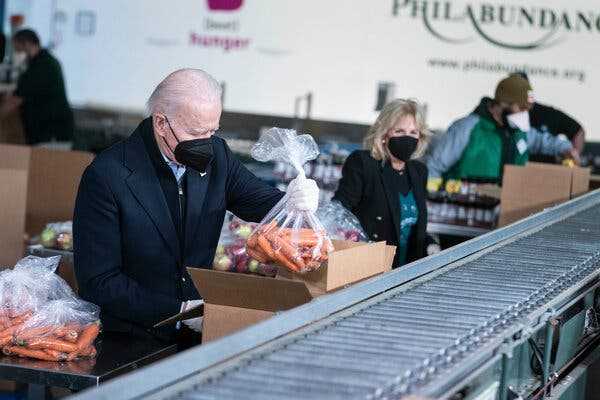The ambitious initiative comes even as food prices have been soaring and food bank lines have been swelling.
-
Send any friend a story
As a subscriber, you have “>10 gift articles to give each month. Anyone can read what you share.
Give this articleGive this articleGive this article

President Biden’s new national strategy emphasizes not only ending hunger but also making healthful food more accessible.
WASHINGTON — The Biden administration is set to embark Wednesday on an ambitious effort to end hunger in the United States by the end of the decade, convening hundreds of policymakers, health activists, farmers and business leaders as it lays out a plan to make healthful food more accessible across the nation.
The White House Conference on Hunger, Nutrition and Health will be the first such gathering since 1969, when President Richard M. Nixon hosted a summit that aimed to “put an end to hunger in America for all time.” President Biden’s meeting comes at a fragile moment for the U.S. economy, as the expiration of stimulus efforts and surging food prices have pushed up food insecurity to levels not seen since early in the pandemic.
“When families can’t afford healthy food options, it’s harder for children to succeed in school, and it can lead to mental and physical health challenges for the whole family,” Mr. Biden said in a statement accompanying the White House plan.
The Biden administration is casting the summit and its focus on food as a key part of its “equity agenda.” The report notes that diet-related diseases disproportionately affect communities of color and people in rural areas.
The plan includes proposals for expanding the Supplemental Nutrition Assistance Program, introducing coverage of “medically tailored” meals to Medicare, moving labels to the front of food packages, encouraging the food industry to lower sodium and sugar, and expanding nutrition research.
The Biden Presidency
With midterm elections approaching, here’s where President Biden stands.
- Defending Democracy: President Biden’s drive to buttress democracy at home and abroad has taken on more urgency by the persistent power of China, Russia and former President Donald J. Trump.
- A Tricky Message: Even as he condemns Trumpism, Mr. Biden has taken pains to show that he understands that not all Republicans are what he calls extremist “MAGA Republicans.”
- On the Campaign Trail: Fresh off a series of legislative victories, Mr. Biden is back campaigning. But his low approval ratings could complicate his efforts to help Democrats in the midterm elections.
- Questions About 2024: Mr. Biden has said he plans to run for a second term, but at 79, his age has become an uncomfortable issue.
Eliminating hunger is a formidable goal, and one that, as Nixon’s failings five decades ago show, has eluded generations of policymakers. Mr. Biden also starts out with many signposts pointing in the wrong direction: Lines at food banks are swelling. Food prices are rising at their fastest rate in four decades. And fears of a recession that could toss more Americans into unemployment lines are growing.
Many of Mr. Biden’s proposals are also hardly guaranteed to be enacted. Some can be accomplished through regulatory measures, Biden administration officials said, but others will require legislation from Congress. It is not clear how quickly some of the proposals could take effect, but there is added urgency as Russia’s war in Ukraine has pushed energy and food prices higher around the world.
The food industry often resists new regulation, and many of the guidelines in the Biden administration plan are voluntary.
Officials in the administration said before the conference that several companies would be announcing commitments to improve food security in the United States. Kroger will work with the American Heart Association on a $250 million “food is medicine” initiative. The National Restaurant Association will work with fast food chains to ensure that kid’s meals only contain water, milk or juice. And Rethink Food, a nonprofit organization, will work with restaurants to divert millions of pounds of unused food to communities that are facing food insecurity.
More healthful eating was also a major priority during the Obama administration. Michelle Obama, the first lady, led the “Let’s Move” initiative, which aimed to eliminate childhood obesity by revamping the way American children eat and play and by reshaping school lunches, playgrounds and medical checkups.
But in 2017, the Trump administration rolled back several of Ms. Obama’s efforts to promote healthy school lunches.
Although food insecurity is a problem, the United States remains far better off than many other countries. According to the World Bank, nearly 193 million people around the world faced food insecurity last year.
A report from the Agriculture Department this month found that about 90 percent of U.S. households were food secure last year, while about 10 percent, or 13.5 million, had difficulty providing enough food for their family members.
Source: nytimes.com